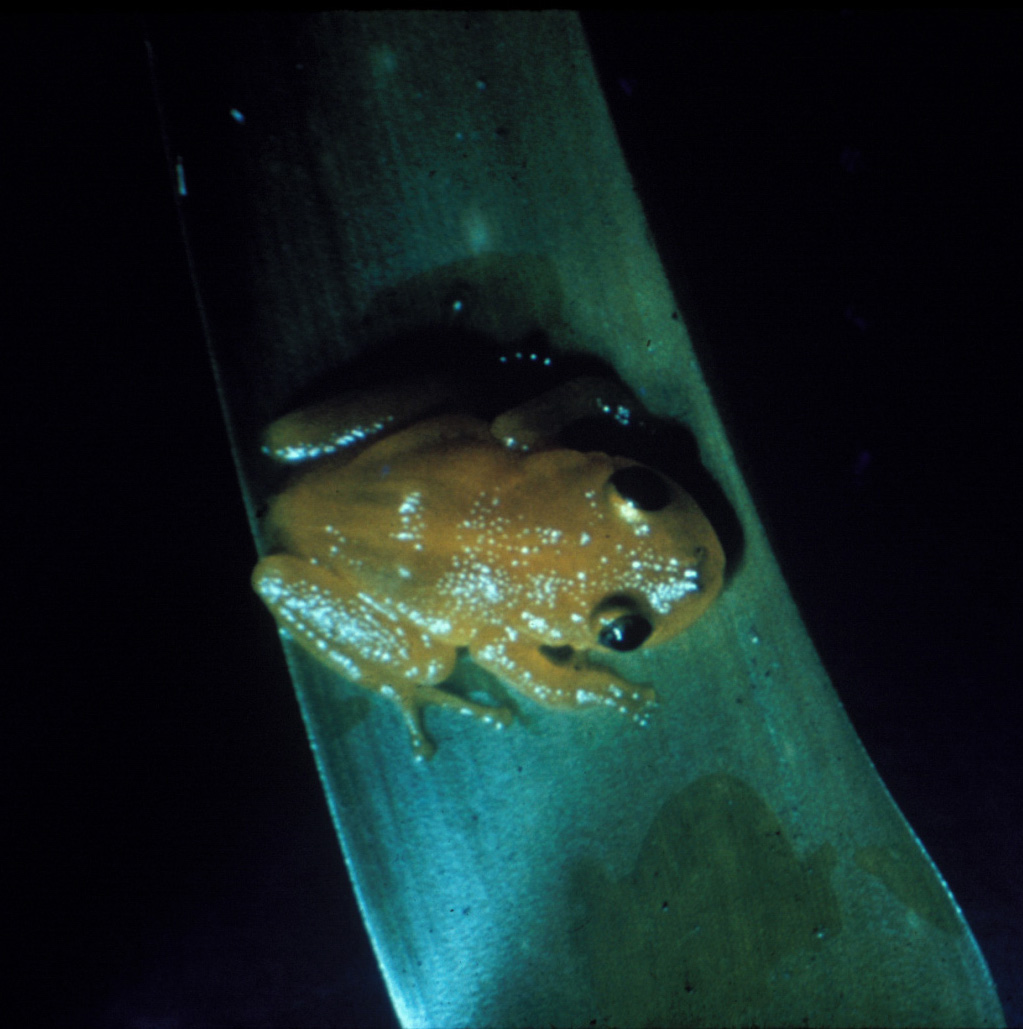- Golden coquí
Taxobox
name = Golden Coqui
status = CR | status_system = IUCN3.1
trend = down

image_width = 240px
regnum =Animal ia
phylum =Chordata
classis =Amphibia
ordo =Anura
superfamilia =Hyloidea
familia =Leptodactylidae
subfamilia =Eleutherodactylinae
genus = "Eleutherodactylus "
subgenus = "Eleutherodactylus"
species = "E. jasperi"
binomial = "Eleutherodactylus jasperi"
binomial_authority = Drewry & Jones, 1976The Golden coquí ("Eleutherodactylus jasperi"; Spanish: Coquí dorado) is a rare and possibly extinct leptodactylid frog species endemic toPuerto Rico .General description
Golden coquís are roughly 3/4 inch (~1.9 cm) long (snout-vent length) and are olive-gold to yellow-gold without pattern. The juveniles resemble adults.
Biology
First reported to science in the 1970s (Drewry & Jones 1976), the golden coquí is ovoviviparous, the only live-bearing species known from the family
Leptodactylidae . The species is restricted to a few genera of water-containingbromeliads in certain moist tropical/subtropical forests and rocky areas.Distribution and Status
Golden coquís have only been found in areas of dense
bromeliad growth in theSierra de Cayey of Puerto Rico between 647 and 785 metres above sea level. The species was last observed in 1981, and surveys of suitable habitat have not found individuals since this date. However, many of the surveys have covered only historical sites and areas next to roads. Due to the apparent disappearance of the population from sites where the species was formerly found, the golden coquí is listed by theIUCN Red List as Critically Endangered (Hedges & Joglar 2004) and byNatureServe as GH (Possibly Extinct). Burrowes et al. (2004) presumed the golden coquí extinct. The species is listed as Threatened by theUnited States under theEndangered Species Act (see, e.g., US Fish & Wildlife Service 1984).Researchers have suggested the fungal disease
chytridiomycosis in combination withclimate change as likely causes of the species' decline. However, since no direct link has been found, and not all species are affected by the fungus, the cause for the decline are still not clear. Habitat loss to homes and agriculture is the major ongoing threat. The areas where the species was discovered have been deforested. These factors, in combination with the species' low reproductive rate, limited dispersal ability, narrow geographic range, and obligate bromeliad-dwelling existence, may be responsible for the species' precarious existence, if not its outright extinction. The species' range includes privately owned land and one protected area, theCarite Forest Reserve . Additional surveys are required to determine if golden coquís survive.References
* Database entry includes a range map and justification for why this species is critically endangered
*Burrowes, P. A., R. L. Joglar, and D. E. Green. 2004. Potential causes for amphibian declines in Puerto Rico. "Herpetologica" 60:141-154.*Drewry, G.E. and Jones, K. 1976. A new ovovivaparous frog, Eleutherodactylus jasperi (Amphibia, Anura, Leptodactylidae) from Puerto Rico. "Journal of Herpetology". 10:161-165.
*Hedges, B. & Joglar, R. 2004. Eleutherodactylus jasperi. In: IUCN 2004. "2004 IUCN Red List of Threatened Species." [http://www.redlist.org www.redlist.org] . Downloaded on 09 August 2005.
*U.S. Fish and Wildlife Service. 1984. Recovery plan for the golden coqui (Eleutherodactylus jasperi). U.S. Fish and Wildlife Service, Atlanta, Ga. 12pp.
Wikimedia Foundation. 2010.
